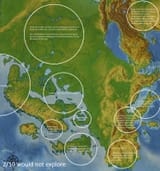>>719700289 (OP)
I don't think I can pinpoint a single game as the best open world, so let me put down some criteria that I consider to be important
>completely traversible from the moment you start the game (or finish the tutorial)
Games that limit your movement to most areas until you complete an arbitrary quest are bad design, because the world isn't really open. Small areas limited by quests are okay, so long as the majority of the world is traversible.
>Sense of distance
"See that mountain? You can go there" but unironically. Edges of the map being the only exception, you have to draw the line somewhere on a map otherwise it would be an awful lot of work to create an entire planet that's lifesize and traversible. This means reaching the end of the open world should also feature good looking distance but are exempt from this rule.
>Dynamic elements
Travelling merchants, characters going to different areas (either due to quests or otherwise), maybe local economies. All of these further the believability of a world being truly open.
>Reactive-ness
Saving a realm, stealing items or even killing people should spur a reaction from the local population. People talking about your deeds or issuing money on your head is a common idea in such games.
>Side activities
Mini games and other things that are not tied to quests, meaning that you can do that whenever you want is also a common idea of good open world design.
A very common example is fishing, but playing a card or dice game, playing an arcade cabinet or any similar activities that you can do in-between quests anytime you want are just as good.
(activities that are tied to quests do not count, you have to be able to do them anytime you want, see as bad example Cyberpunk 2077's street racing which becomes inaccessible after the questline)
>Random events
SOME good examples include (may not have all criteria): Skyrim, Minecraft, RDR2, Bully, Kenshi, Starsector, Witcher 3, Breath of the Wild, Tsushima, Meiers Pirates, WoW










